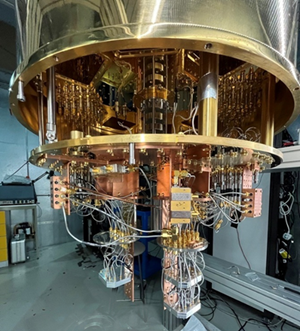 As superconducting quantum computing systems continue to grow and become more complex, the need for accurate measurements is also increasing. The National Physical Laboratory (NPL) supports the emerging quantum computing sector by providing measurement solutions to both industry and academia, while also developing the metrology needed to enable scalable superconducting quantum computing systems.
As superconducting quantum computing systems continue to grow and become more complex, the need for accurate measurements is also increasing. The National Physical Laboratory (NPL) supports the emerging quantum computing sector by providing measurement solutions to both industry and academia, while also developing the metrology needed to enable scalable superconducting quantum computing systems.
Superconducting quantum circuits
Superconducting quantum circuits, ever at the head of the quantum computing wavefront, are a leading platform for quantum computing.
NPL has a long history of expertise in the design and metrology of superconducting devices such as Josephson junctions, superconducting quantum interference devices SQUIDs , resonators etc. and has now also established capabilities in superconducting quantum computing.
This includes the design, fabrication and characterisation of superconducting qubits and other elements of a quantum processor; as well as the auxiliary components, devices and instruments making up a complete quantum computing system.
Our focus is on working closely with academia and industry to develop the metrology capabilities needed for this rapidly growing field. We also use our expertise to contribute to the development international standards for quantum computing.
Our experts can assist in solving measurement problems related to the characterisation superconducting quantum computing hardware and provide consultancy services in developing innovative technologies alongside academia and industry.
All work in our hardware team is done in close collaboration with our experts on quantum software.
Our capabilities include:
- Characterisation of superconducting circuits
- Cryogenic testing of components and systems
- Advice on using the NPL cryogenic (4K) probe station for automated DC testing of devices, in close collaboration with our partners at SuperFab.
Materials for superconducting quantum processors
A major challenge for scaling up superconducting quantum processors is that the circuits suffer from intrinsic sources of decoherence: defects and impurities in the materials the circuits are made from (dielectrics, superconducting metals etc.)
These defects not only cause decoherence and fluctuations in the parameters of qubits, but also cause low frequency, 1/f noise and losses in superconducting resonators used for a range of quantum devices and sensors. By combining measurements of 1/f noise with in-situ ESR using tailor-made resonators, it is possible to quantify these effects and compare different materials and processes used for the fabrication of quantum processors.
We are also developing the next generation of in-situ materials science tools for better understanding the materials used in quantum processors. This includes low temperature scanning probe microscopy tools.
Our capabilities include:
- 1/f noise measurements of superconducting resonators.
- Dielectric loss measurements at mK temperatures.
- Two Level System spectroscopy (TLS Spectroscopy)
- In-situ electron spin resonance measurements (ESR) of superconducting circuits.
References:
Read our work on characterising two-level systems
Read our work on material defects in superconducting quantum circuits
Read our work on Spin-Echo silencing using a Current-Biased Frequency-Tunable Resonator
Our latest work on noise suppression in superconducting circuit by a novel method.
Quantum interfaces & amplification
The integration of auxiliary circuits and devices needed for control and readout of quantum states in superconducting quantum processors presents a significant challenge, crucial for the advancement of quantum computing. Cryogenic components such as filters, attenuators, and radio frequency (RF) switches are key parts of the systems that control the quantum states, while isolators and quantum-limited amplifiers are essential for signal readout. Additionally, components like interconnects and directional couplers are integral to the overall system.
These components ensure the integrity of quantum signals with minimal noise and interference, enabling robust amplification and precise qubit state manipulation. However, their inherent physical sizes pose a considerable challenge occupying large space within the confined environment of a dilution refrigerator. This poses a major concern for scaling up quantum computing infrastructure. We are developing the metrology for next-generation quantum limited amplifiers and scalable control systems, specifically tailored to address these challenges.
Our current capabilities include:
- Measurement of cryogenic amplifiers (e.g., traveling wave parametric amplifier, Josephson parametric amplifier, kinetic inductance parametric amplifier), evaluating parameters such as gain, dynamic range, and return loss.
- Evaluation of microwave performance for cryogenic mixers, focusing on conversion loss, isolation, 1 dB compression point, and return loss.
- Evaluation of the performance of passive and active components and systems for controlling and reading out superconducting qubits.
Find out more about our capabilities in cryogenic testing and calibration of RF components and our Quantum Software team to assist modelling of your QC system.
Would you like to speak to one of NPL’s quantum experts?
Contact a quantum expert